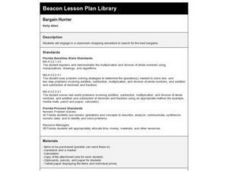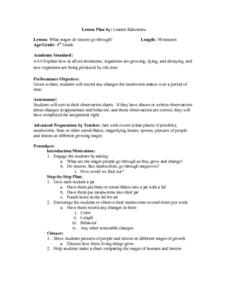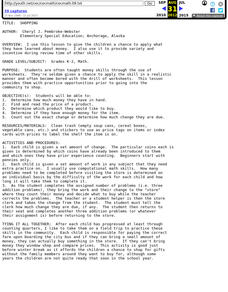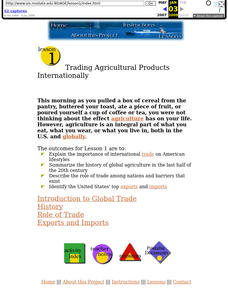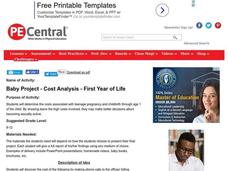Curated OER
Origins: Earth is Born
Students collect and identify micrometeorites from space. Students create collection devices and retrieval methods for matter. They prepare slides and view particles found. Students discuss where the identifiable particles originated...
Curated OER
Runaway Universe
Students complete a hands on activity to determine how scientists use indirect observations to define problems that are not directly measurable. They complete an associate student handout.
Curated OER
FAT FOLLIES
Students, testing various foods for fat content by rubbing food samples on paper. Students identify what and who the US Food and Drug Administration is in reference to the Food Pyramid. Students write the name of each food brought in to...
Curated OER
Mission Meals
Students engage in a investigation of the types of meals that astronauts eat in space while examining the types of nutritional elements needed for optimum physical tasks in space. They are given different foods and then document the...
Curated OER
About Magnets
Second graders conduct simple experiments , observe and explain what they discovered. In this simple experiments activity students design a magnet and make a compass.
Curated OER
Iron for Breakfast
Students examine a common household food and see how accurate the content information is.
Curated OER
Bargain Hunter
Students engage in a classroom shopping adventure to search for the best bargains.
Curated OER
Pinhole Viewer
Students make a pinhole viewer to demonstrate how it inverts light passing through it which produces inverted images.
Curated OER
Static Cling
Young scholars work together to discover the concept of static electricity. They participate in an experiment in which they test different objects charge. They make observations and record them for later use.
Curated OER
Graphing Galore!
Students practice sorting and counting different objects. Using this information, they create graphs on a worksheet given to them. They describe and analyze the results and discuss them as a class to end the activity. They also...
Curated OER
What Stages Do Insects Go Through?
Fourth graders observe mealworms over a period of time and record any changes they observe. They record any changes in color, length, behavior, and any other noticeable changes, identify the stages of the mealworms, and create a chart...
Curated OER
Six Levels of Ecological Organization
Ninth graders describe the six levels of ecological organizations and give examples of each. They also differentiate between food chains and webs and identify trophic and consumer levels in food chain and food webs.
Curated OER
Floaters and Sinkers
Fifth graders define density as the amount of mass per volume a material contains, compare the densities of several types of materials, especially those that sink in water compared to those that float. They use two different methods to...
Curated OER
Dietary Fiber Introduction
Students identify fiber from foods, its sources and function in the body. They also the importance of fiber in the diet and good food sources that one can eat. Finally, students discuss water and its importance with eating fiber and...
Curated OER
Healthy Breakfast
For this reading activity worksheet, students read a 1 page story about Mr. and Mrs. Jones. The story discusses their diet and exercise routines.
Curated OER
Mystery Polymers
Students examine how some natural substances are polymers. In this polymer lesson students complete a lab and give examples of a physical change.
Curated OER
Mars Pathfinder Egg Drop and Landing
Students construct a pathfinder that could land an egg safely. In this physics lesson, students explain the factors affecting the dynamics of falling objects. They evaluate their pathfinder design.
Curated OER
Trade Along the Silk Road
High schoolers do a jigsaw activity that will enable them to understand the dynamics of the Silk Road trade. They will break up into smaller groups to discuss an important section of an article. Large groups engage in an activity about...
Curated OER
Shopping
Students do a shopping simulation in order to have a chance to apply their math skills in a real life fashion. They decide how much money they have, what they want to buy, if they have enough money and how much change they should get back.
Curated OER
Money Sense
Learners identify the value of quarters, dimes, nickels, and pennies, and use a variety of coins to show the value of a dollar. They count the exact amount of purchase.
Curated OER
Trading Agricultural Products Internationally
Students explain the importance of international trade on American lifestyles, summarize the history of global agriculture in the last half of the 20th century, describe the role of trade among nations and barriers that exist.
Curated OER
Baby Project - Cost Analysis - First Year of Life
Students determine the costs associated with teenage pregnancy and childbirth through the child's first year. They consider prenatal and postnatal care for mother and child, clothing, food, equipment, childcare, etc. They present their...
Curated OER
Building an African Compound
Students, in small groups create a model of a compound that might be found in a rural African village. As a class, students orally contribute to a summary paragraph on what they have learned about different forms of shelter found in Africa.
Curated OER
Markets of Africa
Students identify one advantage and one disadvantage to open air markets in Africa. students create a mural on paper to be hung on the classroom wall. Small groups make a stand of something that would be sold at an open air market.
Other popular searches
- Cereal Box Projects
- Alphabet Cereal
- Cereal Crops
- Cereal Box Design
- Cereal Box Book Project
- Anticipatory Set for Cereal
- Carbohydrates and Cereal
- Cereal Grains
- Cereal Box Book Reports
- Breads and Cereals
- Cereals Graphing
- Breakfast Cereals








